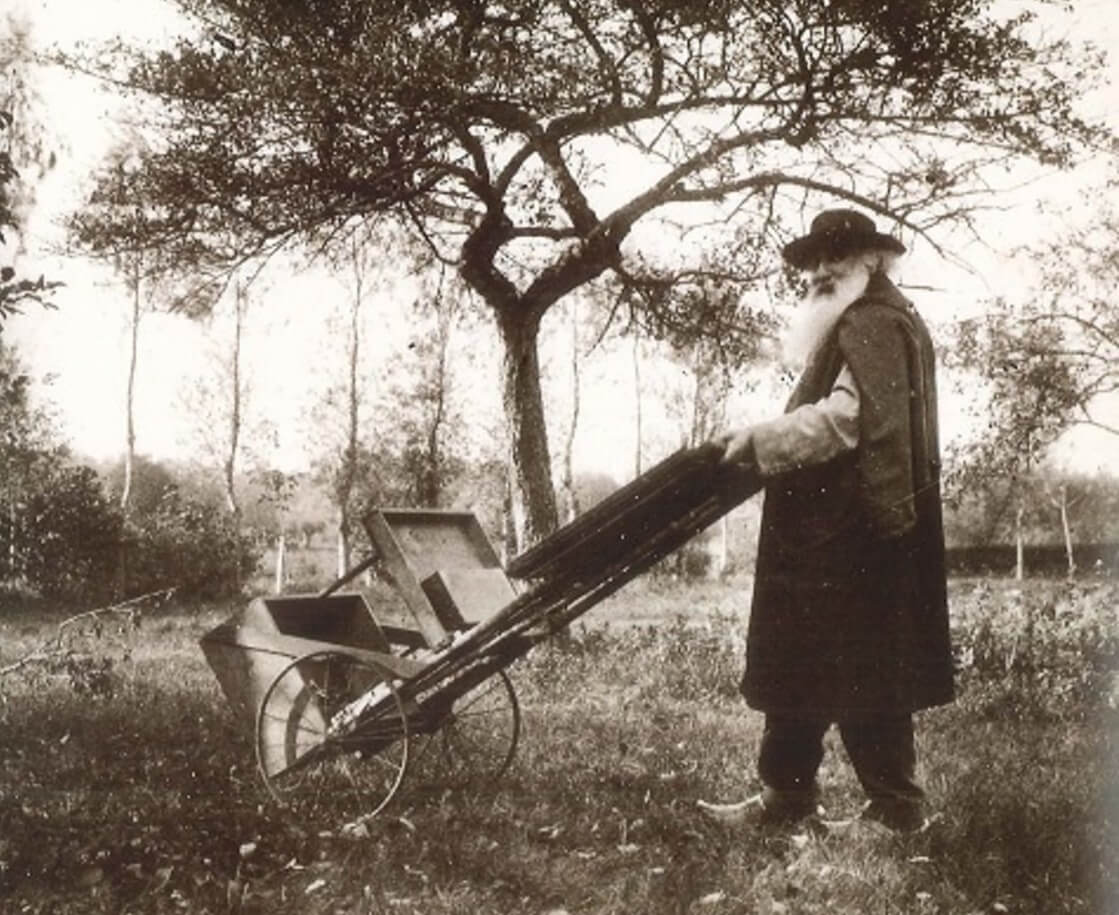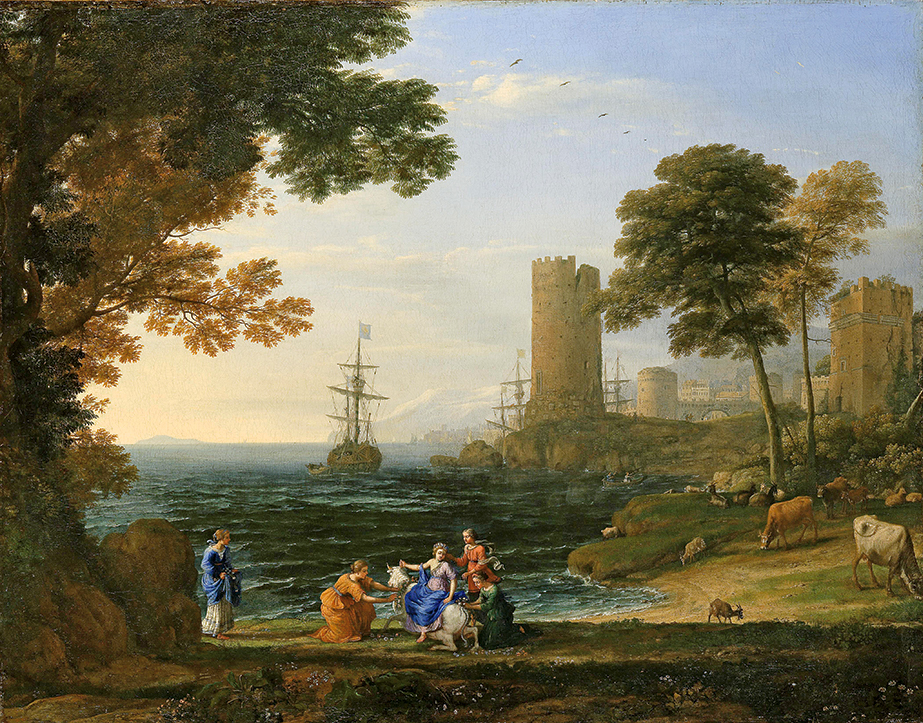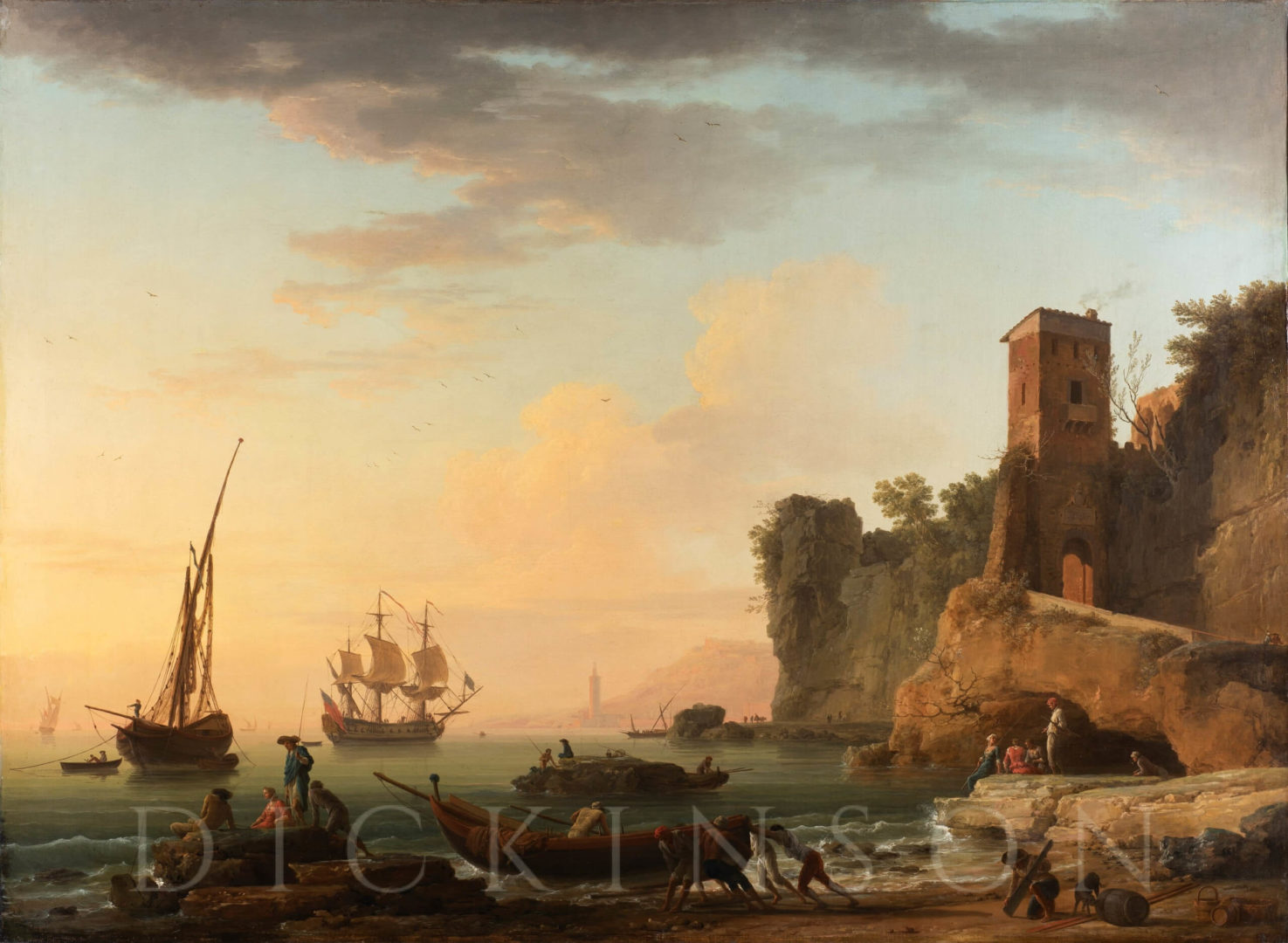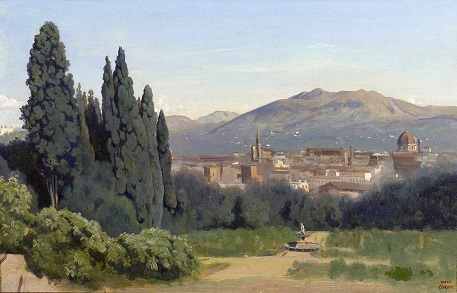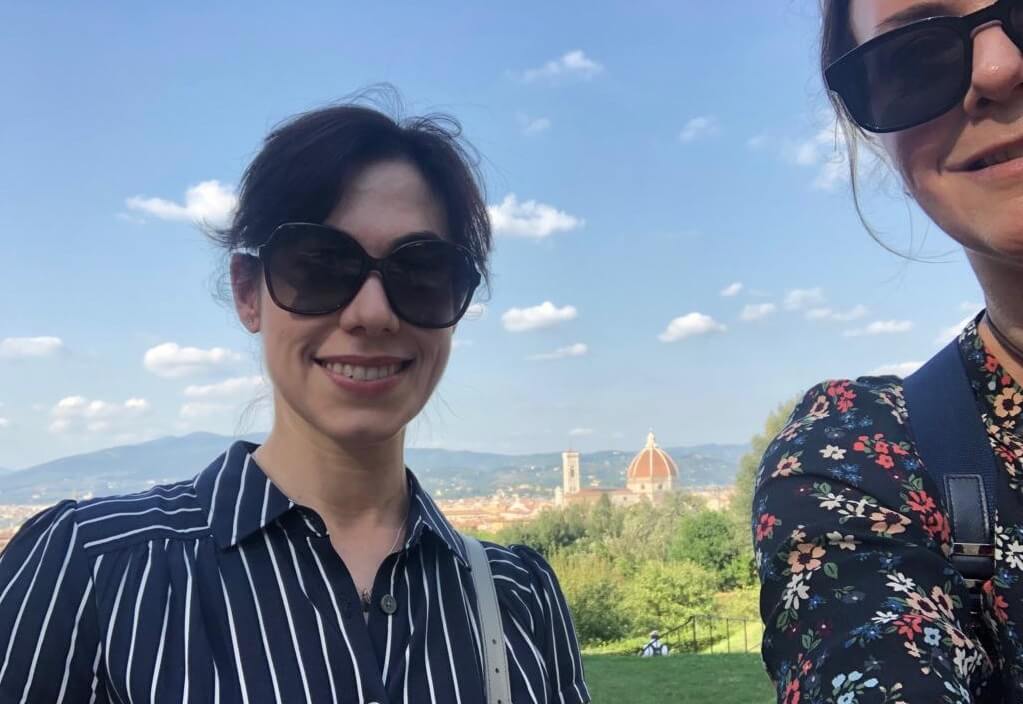When we speak of plein-air painting we might think immediately of Impressionism, the movement whose very name derives from the practice of capturing spontaneous and informal images of the natural world. But the transition from formal studio painting to painting outdoors began much earlier, and was a more gradual process of development, as we can see using as examples landscape paintings currently at Dickinson or highlights we have sold over the years.
Early landscapes, like Hercules Segers’ Mountain Landscape of circa 1625-30, were typically prized for their ability to stir the imagination, rather than for their topographical accuracy; Segers’ view, with its dramatic clifftop dwellings, is far removed from the flat countryside he would have seen in his native Haarlem, just 2 metres above sea level. Similarly, in Italy, Claude Lorrain specialised in idealised views inspired by the Italian campagna, which often featured Biblical or mythological episodes. His Coastal view with the abduction of Europa by Jupiter (c. 1645) sold by Dickinson to the J. Paul Getty Museum, combines Neapolitan-style towers with distant snow-capped mountains in a wholly imaginary view that nevertheless feels ‘Italian’. Indeed, although Claude almost never painted topographical landscapes, his studio paintings are based on his many plein-air sketches, lending them a sense of topographical fidelity.
Claude Lorrain, Coastal view with the abduction of Europa by Jupiter, c. 1645, oil on canvas
The enduring popularity of Claude’s landscapes among both Italian collectors and the many Grand Tourists who visited Italy in the 18th century led to a host of followers. Some, like Claude, painted Italianate views loosely based on sketches made on the spot; Claude-Joseph Vernet, for instance, found favour with works such as Marine Landscape with tower and fishermen hauling in their nets (1775), which suggests the Amalfi coast and was presumably based on sketches made on the spot. Unlike Claude, though, Vernet also painted topographical views, such as The Port of Genoa, although even these were often ‘improved’ from life at the expense of strict accuracy. Patrons tended to be less concerned with absolute accuracy than with the mood of a painting and its ability to convey the sense of a place.
Claude-Joseph Vernet, The Port of Genoa, 1752, oil on canvas
Sometimes, however, patrons were looking for views of a particular location they had visited, and in Venice and the Veneto, artists like Canaletto and his nephew and pupil Bellotto were able to cater to this need. Both sketched prolifically, and painted views of important sites or landmarks (although they also painted capricci, or wholly imaginary views). Still, although they were recognisable and based on drawings taken from life, these views could be adjusted or enhanced without compromising their value as souvenirs, in the manner of modern holiday photos or postcards. Canaletto continued to produce vedute of Venetian landmarks for English patrons in England, such as his view of The Redentore, Venice, of circa 1746. Bellotto’s A View of the Mills at Dolo on the Brenta was painted around the same time (c. 1743), and may have been based on compositions by his uncle Canaletto; this version was sold by Dickinson to a private collector.
In the early 19th century, emotion in landscape painting was as important as accuracy, with patrons developing a taste for the Sublime in both art and literature: views such as Joseph Mallord William Turner’s The Dark Rigi (1842) and John Constable’s Hadleigh Castle: A distant view (c. 1828-29), for instance, both sold by Dickinson, are as notable for their awe-inspiring sense of the grandeur and power of nature as they are for the subjects themselves. Also sublime is Edward Lear’s The Forest of Bavella, Corsica (1868), which emphasises the imposing height of the mountains by allowing them to stretch nearly to the top of the canvas. And although this work was painted in the artist’s studio in Britain, it is based closely on sketches made on the spot, lending it a sense of accuracy and immediacy. And 19th century artists continued to strive for a balance between accuracy and a pleasing composition: Jean-Baptiste-Camille Corot’s 1834 Florence, Vue prise des Jardins Boboli was painted in oil on paper, which suggests it was originally a plein-air sketch, but Corot has nevertheless taken care to add a grove of poplars in the foreground according to the model established by Claude, for the sake of compositional interest. Although this study may never have been intended for sale – indeed, it was left in Corot’s studio at his death – its sense of freshness and immediacy appeals to the modern collector raised on Impressionist views, and it was sold by Dickinson.
Jean-Baptiste-Camille Corot, Florence, Vue prise des Jardins Boboli, 1834, oil on paper
Dickinson’s Molly Dorkin and Emma Ward visiting the Boboli Gardens in Florence
In the second half of the 19th century, the Impressionists played an important role in popularising plein-air views over formal studio compositions, and blurring the line that had long existed between sketch and finished painting. The Impressionists were also aware of, and responding to, developments in early photography, which relied on long shutter speeds and often conveyed a sense of motion and the passage of time through a slight blurriness. Some painters, like Degas, were also photographers themselves. Claude Monet is best known for series such as the Meules, which repeat an unremarkable subject matter – in this case haystacks in a field – in order to focus on the varied effects of light and shadow, temperature, and other transient elements. This 1888-89 Meule, Hiver, Temps Brumeaux, sold by Dickinson to a private collector, casts the haystack in a the warm pink light of dawn or dusk, but Monet also carried brushes and canvas into the fields when they were covered in frost in order to capture the effects of the winter snow.
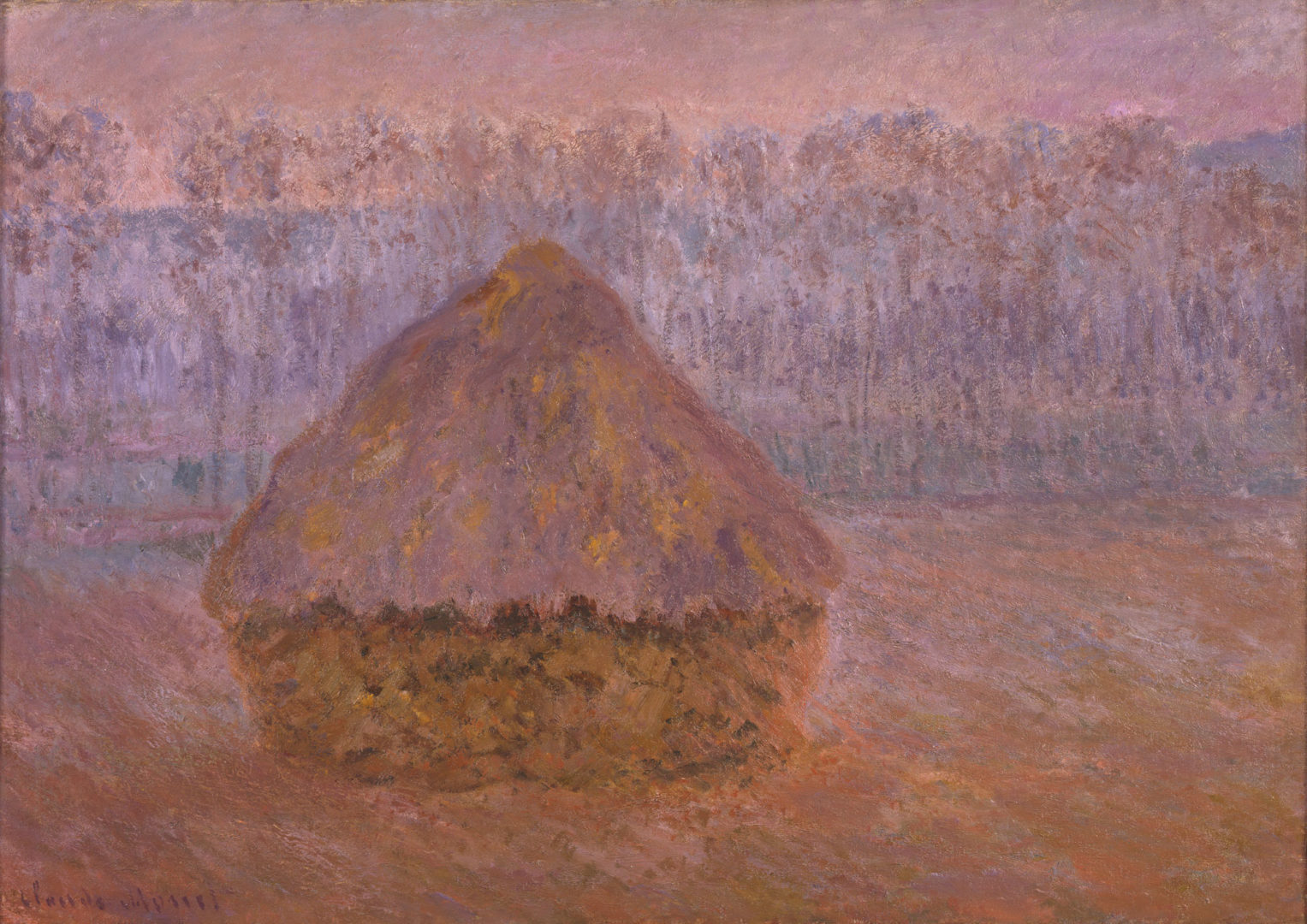
Like Monet, Camille Pissarro also favoured series, and was inspired by the urban as well as the rural landscape: views like Le Pont Neuf, Effet de Neige (1901), sold to a private collector, use plein-air painting techniques to interpret the Parisian cityscape. Alfred Sisley, too, favoured series of local views in varying light and weather conditions: the artist’s L’Abreuvoir de Marly-le-Roi (c. 1875) considers a reservoir located just a few blocks from his country residence.
Camille Pissarro with his easel, c. 1900
Among the Post-Impressionists, Van Gogh is valuable to scholars of plein-air painting for the information and insights contained in his many letters to his brother Theo and other correspondents. In July 1885, the same month he painted Paysanne devant une chaumière, sold by Dickinson at TEFAF Maastricht 2020 to a private collector, he wrote to Theo: ‘Just try going outside and painting things on the spot! All sorts of things happen then. I had to pick off a good hundred or more flies from [my] canvases….not to mention dust and sand [nor] the fact that if one carries them through heath and hedgerows for a couple of house, a branch or two is likely to scratch them…and that the effects one wants to capture change as the day wears on.’ It is clear that Van Gogh was interested not only in capturing the appearance of a place but also the more transient effects of weather and light as accurately as he could.
In the modern area, in many ways, landscape painting has come full circle, with artists once again concerned with capturing the sense of a place and relying on imagination rather than topographical accuracy; works such as Gerhard Richter’s Niagara Falls (1965) or Anselm Kiefer’s Tomb of the Unknown Painter (1983), both sold to private collections by Dickinson, are primarily concerned with feeling, and use the landscape as a vehicle. Regardless of the intended message or purpose, the fascination with the landscape, whether imaginary, topographical, rural or urban, endures among both artists and collectors.


